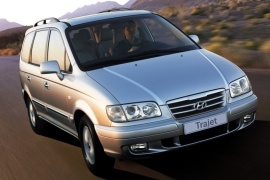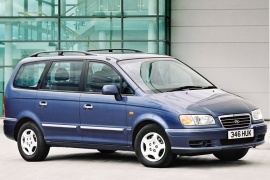HYUNDAI Trajet Models/Series Timeline, Specifications & Photos
First production year: 2000
Engines: Gasoline, Diesel
Body style: Van
Inspired by the American MPVs, Hyundai dared to throw a seven-seat minivan on the market. But it was too late for it.
Sometimes a carmaker should wait and properly develop a new vehicle rather than jump in with something it has in the yard and adapt it to the market's needs. But if it waits too long, the market trend might shift, and the carmaker will lose. Hyundai came late to the party in that segment. First, it came with a licensed-based Mitsubishi, and then, in 1999, it introduced the Trajet. A vehicle which was refreshed in 2004.
The Trajet was built on the same platform as the Hyundai Sonata, but thankfully it showed a different front fascia. Its horizontal, slim headlights and the grille with horizontal slats were specific to that Korean minivan. Unlike the U.S. carmakers, which offered sliding doors, Hyundai chose Honda's way to build the car with regular ones, like on the Honda Shuttle.
The interior was fit for up to seven passengers. It was a good choice, especially for the European and Asian markets. For the dashboard, Hyundai took its inspiration from the American carmakers. It installed the gear selector on the steering column and placed a shorter center stack eliminating the center console. For specific markets and engines, the Korean carmaker installed a 5-speed manual gear-stick between the front seats.
Under the hood, Hyundai installed a choice of diesel and gasoline engines fit for most of the markets. The most fuel-efficient versions were powered by a 2.0-diesel unit, while the top performer featured a 2.7-liter V6.
Hyundai decided to offer a proper seven-seat MPV for the market and built it on the same platform as the Sonata and Santa Fe's first-generation generation.
With an increased demand for large family vehicles or VIP shuttles, Hyundai noticed that it could do something about it and created the Trajet. The word, itself, meant a route to follow, and the vehicle was adequate for that.
The car's front featured two horizontal headlights that resembled some of the U.S. minivans and a small, chromed grille. Its front bumper sported a design more appropriate to a sedan than to a minivan, but it worked for a family vehicle. Its tall greenhouse made it look like a large station wagon with regular, front-hinged doors. The carmaker installed a big liftgate at the back, which required some considerable room behind it to open it.
Hyundai installed three seat rows with room for up to eight occupants, but it also offered it a seven-seat in a 2-2-3 configuration. The middle row could tilt and tumble to make room for the last row passengers. At the front, the high-seating position offered a confident feeling. The curved SUV-like dashboard design featured a center stack where the carmaker installed the HVAC controls, the audio system, and the gear-stick.
Under the hood, Hyundai provided a choice of three engines ranged between 112 hp and 170 hp. The former was the diesel version, which was the preferred option for the Europeans, while on other markets, the Trajet was mostly sold with the 2.0-liter or the lively 2.7-liter V-6.

